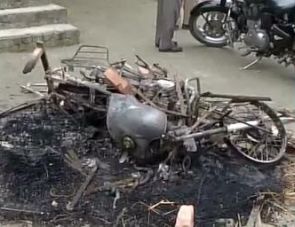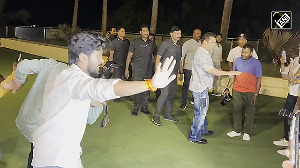 'The horrific episode of January 18 in Muzaffarpur, Bihar, is quite different from what happened in Muzaffarnagar, UP, in September 2013.'
'The horrific episode of January 18 in Muzaffarpur, Bihar, is quite different from what happened in Muzaffarnagar, UP, in September 2013.'
'The Akhilesh Yadav-led administration and riot-mongers among our political formations need to learn lessons from the response of state and society to violence in Muzaffarpur,' says Mohammad Sajjad.
On January 18, 2015, violence broke out in the Ajitpur-Bahilwara village, near Saraiya, district Muzaffarpur in north Bihar. It killed nearly five people and almost all the 56 Muslim (Pasmanda) households, were looted and burnt.
The provocation was an inter-faith love affair: To Hindutva zealots, was it a case of 'love-jihad' in reverse, or a case of 'honour killing?'
A Hindu boy (of the Mallah, fishermen caste) named Bhartendu, 20, (reportedly in love with a girl from a Pasmanda Muslim community, both belonging to the same village, and both studying in the same LS College in Muzaffarpur), went missing since January 9, 2015.
A report against a Muslim from the village was lodged with the Saraiya police about the kidnapping.
The local police is alleged to have remained rather lethargic despite the fact that this issue carried a high degree of communal volatility and sensitivity, given the fact that the accused was the Muslim girl's brother, and that the marriage of the two was being resisted -- at least -- from the girl's family. The girl's stepmother happens to be from the Hindu caste of Kahaar (palanquin-bearers).
A few months ago, ahead of the Chhath puja, there was acute communal tension between the Hindu Mallahs and Pasmanda Muslims in Turkauliya village in the same Saraiya-Paroo thana area.
The violence could be avoided with prompt administrative interventions, prolonged persuasion, as also with the initiatives of the local people for inter-community dialogue.
Here, a Muslim was alleged to have thrown human excreta from an overflowing and congested tank of his septic tank into the canal in which Chhath puja was being performed for ages.
It is said that a Muslim lumpen asked him to do so, because people usually use such excreta as highly fertile manure for their crops. This lumpen has some political aspirations and is known to raise provocative issues to mobilise his co-religionists behind himself.
On January 18, 2015, a farmer of Ajitpur-Bahilwara, while spreading fertiliser in his wheat fields, saw dogs digging into the ground and suddenly sighted a human hand.
The dead body was identified as that of Bhartendu. This sparked off the violence.
Ironically, the Bharatiya Janata Party MLA of Paroo-Saraiya, Ashok Singh's native village and his base of political operation and everyday political transaction is almost adjacent to the unfortunate village of Ajitpur-Bahilwara.
Reports allege that the BJP MLA created some obstruction in letting the police reach the spot of violence. There are also reports that the girl's brother Vicky is close to the BJP MLA.
A history of the politics and economy of the region may help us understand the simmering and recurring tensions.
It could possibly be an irony that this village lies close to the historic village of Vaishali, the birth place of Lord Mahavir, and deeply associated with Lord Buddha too, both saints of peace and non violence.
Besides, it also known for the popular shrine of the 15th century Sufi saint Shaikh Qazin Shuttari.
Another irony is that the boy, brutally killed with communal prejudice, was an alumnus of the LS College. Established in 1899, the institute was the outcome of strong Hindu-Muslim cooperation in the movement for modern education, launched in 1868 by Syed Imdad Ali, the then subordinate judge of Muzaffarpur (Tirhut), and a friend of his counterpart in Aligarh, Sir Syed Ahmad.
Significantly, at least post-Independence, Muzaffarpur has remained almost absolutely free from communal violence. Only those parts of Muzaffarpur, which now constitute the districts of Sitamarhi and Sheohar, had seen major communal violence post-Independence.
Even in the late-colonial period, the only major communal violence in Muzaffarpur was in the village of Benibad (September 1946), and here too the immediate cause was inter-faith marriage.
Ali Hasan, a Muslim from Benibad village, working in Calcutta had married a Hindu girl from Calcutta named Kalyani Dey (renamed Nur Jahan).
This provoked the locals, and major violence broke out. The police could not control it as quickly because of the mechanical breakdown of the truck carrying a troupe of police. (I have given these details in my book on Muzaffarpur, 1857-2012, Contesting Colonialism and Separatism: Muslims of Muzaffarpur since 1857, Primus, Delhi, 2014).
In recent years, more particularly since the breakdown of the coalition between the BJP and the Janata Dal-United in Bihar in June 2013, things have started changing for the worse very rapidly.
India witnessed major communal tension and violence during the 1920s, 1940s, 1980s. Ever since, communal tension has been a sad reality of our lives besides caste-based oppressive discriminations which has existed since ancient times in our civilisation.
Incidentally, these were the decades when growing affluence among the Muslims created the middle classes, and thereby ensued competitions and rivalries in all walks of life -- education, politics, share in power, trade and manufacturing, etc.
The Pasmanda Muslims of Ajitpur-Bahilwara village have also acquired perceptible prosperity only recently. They may not be acquiring much of education, but their trade in tyre-tube repair and sales, and motor-parts, quite a few in Asansol, and few others in blue collared jobs in the Middle East, has fuelled aspirations of a share in the structures and processes of power, particularly in the panchayat elections.
This was already becoming an eye-sore among a section. Another cause of economic conflict is that in the local haats and markets, the poultry chicken sellers are usually Muslims, but of late, some Hindus have also entered this business.
This should also be brought to the fore that in the villages of Bihar today, migration for livelihood has made male presence very minimal, and some of the few unemployed youth in villages, also degenerate into becoming lumpen-cum-brokers of nationalised banks, of police thanas, and in community development blocks from where the panchayat development funds and the funds for social welfare schemes flow.
There are reports in the whispers and gossip of the villagers that such lumpens also indulge in the flesh trade and this is said to be one of the ways of bribing sections of local officials, police and politicians.
In my book on the Muslims of Muzaffarpur, I have given a long chapter on a Muslim inhabited village, Turkauliya, profiling a criminal who grew in strength through the active support of his community as well as local officials.
Such outlaws eventually turn into politicians soon. Crime and violence are thus increasingly getting deeply embedded in our social fabric.
Thus far, in most cases of communal riots, the rioters have gone scot free. In fact, one of the biggest failures of Indian democracy has been the utter failure of the criminal justice system in punishing rioters and riot-mongers.
In today's Muzaffarpur, comprising the Muzaffarpur and Vaishali Lok Sabha seats, the Hindu Ati Pichhrha caste of Mallahs (bearing the surnames of Nishad, Sahni, and sometimes Manjhi) have become the 'dominant caste,' replacing Rajputs and Bhumihar-Brahmins.
Many times, Muzaffarpur has elected its parliamentarian from the Mallah community, including the incumbent who belongs to the BJP.
In Vaishali (Ajitpur-Bahilwara of Saraiya-Paroo lies in the Vaishali Lok Sabha constituency, which elected Rama Singh of the Loktantrik Janata Party in alliance with the BJP, defeating the Rashtriya Janata Dal's Professor Raghuvansh Prasad Singh), the JD-U candidate in 2014 was a Mallah and unlike most of Bihar's parliamentary seats, the JD-U candidate from Vaishali secured a very significant number of votes in May 2014.
This region is also infested with Maoists and quite often statements issued by local politicians complain that most Maoists are Mallahs. Cutting across religious and caste-barriers, the local population would express fear about the Mallahs, their community solidarity and their alleged penchant for violence.
This is a kind of stereotype about the Mallahs that exists among the local population. In this way, the Ajitpur-Bahilwara violence may not be said to be religious in nature in the way we have understood it conventionally, as non-Mallah Hindus not only remained away from the violence, they also extended all possible help in protecting the people and in relief measures.
In fact, today, the local people -- Hindus and Muslims -- vehemently react against the media for portraying it as a conventional religious strife.
Therefore, if at all there is any attempt by any communal organisation to create Hindu-Muslim polarisation or an attempt to create a communal wedge between the Ati Picchrha communities of Hindus and Muslims for the purposes of the forthcoming assembly elections in Bihar in October-November 2015, then it could possibly be seen as a gratifying silver line as both Hindus and Muslims stand united to get the culprits of Ajitpur-Bahilwara booked.
The Saraiya police was allegedly lethargic in arresting the killers which degenerated and spiralled into a more sinister group violence, but the state response to this violence has since then been very prompt.
Reports say quite a large number of the accused have since been arrested including the alleged killers. Enquiries are underway, payment of compensation, and relief measures from the state are also said to be satisfactory in an unprecedented way.
Public opinion in the area shows genuine outrage against the incident. This horrific episode of January 18, 2015 in Muzaffarpur is quite different from what happened in Muzaffarnagar, Uttar Pradesh, in September 2013.
The Akhilesh Yadav-led administration in UP as well as riot-mongers among our political formations need to learn a few lessons from this response to violence of the state and society in Bihar's Muzaffarpur.
Mohammad Sajjad teaches History at the Aligarh Muslim University and has published two books, Contesting Colonialism and Separatism: Muslims of Muzaffarpur since 1857 and Muslim Politics in Bihar: Changing Contours.
Image: The violent clashes in Bihar's Muzaffarpur district. Photograph: ANI/Twitter











 © 2025
© 2025